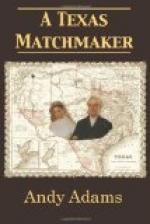That morning after a big rodeo on the Nueces, well above the Ganso, we returned to camp. Throwing into our herd the cut of less than a hundred secured on the morning round-up, Uncle Lance, who had preceded us, rode out from the wagon with a carbine. Allowing the beeves to scatter, the old ranchero met and rode zigzagging through them until he came face to face with the pinto ladino. On noticing the intruding horseman, the outlaw threw up his head. There was a carbine report and the big fellow went down in his tracks. By the time the herd had grazed away, Tiburcio, who was cooking with our wagon, brought out all the knives, and the beef was bled, dressed, and quartered.
“You can afford to be extravagant with this beef,” said Uncle Lance to the old cook, when the quarters had been carried in to the wagon. “I’ve been ranching on this river nearly forty years, and I’ve always made it a rule, where cattle cannot be safely handled, to beef them then and there. I’ve sat up many a night barbecuing the ribs of a ladino. If you have plenty of salt, Tiburcio, you can make a brine and jerk those hind quarters. It will make fine chewing for the boys on night herd when once we start for the coast.”
Following down the home river, we made ten other rodeos before we met Deweese. We had something over a thousand beeves while he had less than eight hundred. Throwing the two cuts together, we made a count, and cut back all the younger and smaller cattle until the herd was reduced to the required number. Before my advent at Las Palomas, about the only outlet for beef cattle had been the canneries at Rockport and Fulton. But these cattle were for shipment by boat to New Orleans and other coast cities. The route to the coast was well known to my employer, and detailing twelve men for the herd, a horse wrangler and cook extra, we started for it, barely touching at the ranch on our course. It was a nice ten days’ trip. After the first night, we used three guards of four men each. Grazing contentedly, the cattle quieted down until on our arrival half our numbers could have handled them. The herd was counted and received on the outlying prairies, and as no steamer was due for a few days, another outfit took charge of them.




